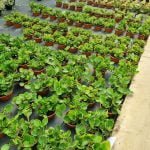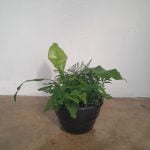Showing 73–84 of 296 resultsSorted by latest
-
Sale!

Dryopteris Remota Remote Wood Fern 14cm Pot
Original price was: R155.00.R99.99Current price is: R99.99.Add to cartDryopteris Remota Remote Wood Fern 14cm Pot
-
Sale!

Dryopteris Affinis 14cm Pot
Original price was: R155.00.R99.99Current price is: R99.99.Add to cartDryopteris Affinis 14cm Pot
-
Sale!

Dryopteris Erythrosora Compact 23cm Pot
Original price was: R395.00.R285.00Current price is: R285.00.Add to cartDryopteris Erythrosora Compact 23cm Pot
Common Name: Copper Shield FernDryopteris erythrosora, commonly known as Autumn Fern or Japanese Shield Fern, is a species of fern native to East Asia, including Japan, China, and Korea. It is a popular ornamental fern known for its vibrant and ever-changing foliage colours throughout the seasons.
Appearance: Autumn Fern has fronds that can reach a height of about 60 to 90cm and a spread of 1 30 to 60cm. The fronds are lance-shaped and composed of multiple leaflets. The young fronds emerge in spring with a striking coppery or bronze colour, which gradually matures to deep green as they age. In autumn, the fronds take on a bronze or reddish coloration, hence the name “Autumn Fern.”
Growth habit: This fern forms a clumping habit with its rhizomes, creating a dense and attractive foliage display. It is a deciduous fern, meaning that the fronds will die back in winter and new growth will emerge in spring.
Light and temperature: Autumn Fern thrives in partial shade to full shade conditions. It prefers a protected location with indirect light. It can tolerate a range of temperatures but generally prefers cool to moderate climates.
Watering and humidity: The fern prefers consistently moist soil. It should be watered regularly to keep the soil evenly moist, especially during dry periods. However, it is important to avoid waterlogged conditions. It can tolerate average indoor humidity levels but appreciates higher humidity levels.
Soil and fertilisation: Plant Autumn Fern in well-draining, humus-rich soil. It can adapt to various soil types but prefers a slightly acidic to neutral pH. Adding organic matter, such as compost or peat moss, to the planting area can help improve the soil’s moisture retention. Fertilise in spring with a balanced slow-release fertiliser.
Care tips: Remove any dead or damaged fronds regularly to maintain the fern’s appearance. Mulching around the base of the plant can help retain moisture and regulate soil temperature. Autumn Fern is generally low-maintenance once established. It can benefit from dividing clumps every few years to control its size and rejuvenate growth.
Autumn Fern is a beautiful and versatile fern that adds texture and colour to shaded areas in gardens or as a container plant. Its changing foliage colours make it particularly appealing during the spring and autumn seasons. With proper care and suitable growing conditions, this fern can thrive and bring a touch of elegance to your outdoor or indoor space.
-
Sale!

Cyrtomium Fortunei Clivicola 23cm Pot
Original price was: R395.00.R285.00Current price is: R285.00.Add to cartCyrtomium Fortunei Clivicola 23cm Pot
Common Name: Japanese Holly FernBright Indirect Light
Morning Sun
Medium Watering
Feed Monthly (feed every second month in winter)Cyrtomium fortunei, commonly known as the Fortune’s Holly Fern, which is a well-known and widely cultivated fern species.
Appearance: Cyrtomium fortunei is an evergreen fern with glossy, leathery fronds. The fronds are typically pinnate, meaning they have multiple leaflets arranged along a central axis. The leaflets are dark green and have serrated edges. The fronds can grow to be around 30 to 90cm in length, depending on the specific variety.
Growth habit: This fern has an upright and clumping growth habit. It produces a rosette of fronds that arise from a central rhizome. Over time, the fern can gradually spread by producing new fronds and rhizomes, forming a dense clump.
Light and temperature: Cyrtomium fortunei thrives in partial shade to full shade conditions. It can tolerate a wide range of temperatures but generally prefers cool to moderate climates.
Watering and humidity: The fern prefers consistently moist but well-draining soil. It should be watered regularly to keep the soil evenly moist, especially during dry periods. However, it is important to avoid waterlogged conditions. It can tolerate average indoor humidity levels but appreciates higher humidity levels.
Soil and fertilisation: Plant Cyrtomium fortunei in well-draining soil that retains some moisture. A mix of peat moss, perlite, and other organic matter can provide the ideal growing conditions. Fertilise the fern with a balanced houseplant fertiliser at a diluted strength every two to four weeks during the growing season (spring to summer) to provide necessary nutrients.
Care tips: Remove any dead or damaged fronds regularly to maintain the fern’s appearance. Mulching around the base of the plant can help retain moisture and regulate soil temperature. Cyrtomium fortunei is generally low-maintenance once established. It can tolerate a range of conditions but prefers a relatively stable environment.
-
Sale!

Blechnum Volcano 40cm Pot
Original price was: R850.00.R599.99Current price is: R599.99.Add to cartBlechnum Volcano 40cm Pot
-
Sale!

Peperomia 17cm Bowl
Original price was: R225.00.R149.99Current price is: R149.99.Select options This product has multiple variants. The options may be chosen on the product pagePeperomia 17cm Bowl
-
Sale!

Neoregelia 16cm Hanging Basket
Original price was: R225.00.R129.99Current price is: R129.99.Add to cartNeoregelia 16cm Hanging Basket
-
Sale!

Nematanthus M. Glow 20cm Hanging Basket
Original price was: R225.00.R149.99Current price is: R149.99.Add to cartNematanthus M. Glow 20cm Hanging Basket
-
Sale!

Cordyline Glauca 17.5cm Pot
Original price was: R350.00.R230.00Current price is: R230.00.Add to cartCordyline Glauca 17.5cm Pot
Common Name: Hawaiian Ti Plant, Good Luck Plant and Ti PlantMorderate Watering When Soil Is Dry On Top
Bright, Indirect Light
Monthly Feeding -
Sale!

Bromeliad Vriesea 15cm Pot
Original price was: R200.00.R125.00Current price is: R125.00.Add to cartBromeliad Vriesea 15cm Pot
-
Sale!

Coleus Wasabi 15cm Pot
Original price was: R175.00.R125.00Current price is: R125.00.Add to cartColeus Wasabi 15cm Pot
Coleus, known for its vibrant and colourful foliage, is a popular choice for gardens and indoor plant collections. To grow healthy and attractive coleus plants, you should provide them with the right growing conditions:
Light
Indoor Coleus: When growing coleus indoors, place them in bright, indirect light. Avoid direct sunlight, as it can scorch the leaves.
Outdoor Coleus: If growing coleus outdoors, they can tolerate some morning sun, but they generally prefer partial to full shade, especially in hot climates. Too much direct sun can fade the vibrant colours of the leaves.Temperature
Coleus prefers moderate temperatures. They do well in the range of 21-37°C. Protect them from frost and cold drafts.Soil
Use a well-draining potting mix or garden soil with good drainage. A slightly acidic to neutral pH (around 6.0-7.0) is suitable for coleus.Watering
Keep the soil consistently moist but not waterlogged. Water when the top inch of the soil feels dry, but don’t let the plant wilt. Coleus prefers relatively high humidity levels.Fertilisation
Fertilise your coleus plants every 4-6 weeks during the growing season (spring through early fall) with a balanced, water-soluble fertiliser. Avoid over-fertilisation, as it can lead to leggy growth with less vibrant foliage.Pruning
Regularly pinch or trim back the tips of coleus stems to encourage bushier growth and prevent legginess. You can also remove any flower spikes that form, as coleus is typically grown for its foliage, not its flowers.Container Growing
Coleus can thrive in containers. Make sure the pots have drainage holes to prevent overwatering and root rot. -
Sale!

Mixed Fern Bowl 20cm
Original price was: R425.00.R269.99Current price is: R269.99.Add to cartMixed Fern Bowl 20cm
20cm Bowl filled with assorted fern plants
